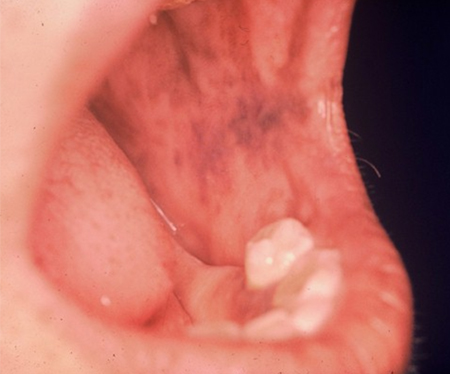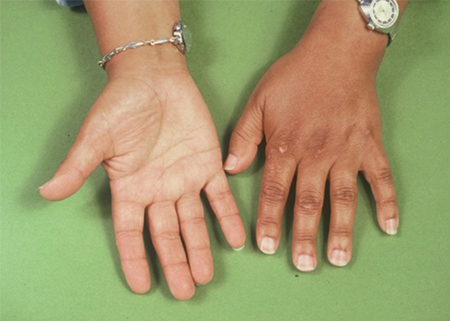History and exam
Key diagnostic factors
common
presence of risk factors
Risk factors include female sex and known autoimmune diseases, such as type 1 diabetes, rheumatoid arthritis, pernicious anaemia, coeliac disease, vitiligo, or autoimmune thyroid disease.[3][9][13] Risk factors for adrenal haemorrhage or haemorrhagic infarction include thromboembolic and/or hypercoagulable states, such as antiphospholipid syndrome, sepsis, and heparin-induced thrombocytopenia.[9][17] Patients taking anticoagulants are at increased risk of adrenal haemorrhage.[2]
fatigue
Reported by almost all patients.[9]
May be described as lethargy, weakness, or tiredness.
anorexia
Present in almost all patients.[9]
weight loss
Observed in almost 100% of patients.[9]
hyperpigmentation
Observed in 80% to 94% of patients.[9]
Present in mucosa and sun-exposed areas. More pronounced in palmar creases, areas of friction, and scars.[3][Figure caption and citation for the preceding image starts]: Generally hyperpigmented young man with primary adrenal insufficiency: exaggerated pigmentation over pressure points on elbowsFrom the personal collection of T. Joseph McKenna, MD; used with permission [Citation ends]. [Figure caption and citation for the preceding image starts]: Area of buccal hyperpigmentation where teeth pinch mucous membrane while chewingFrom the personal collection of T. Joseph McKenna, MD; used with permission [Citation ends].
[Figure caption and citation for the preceding image starts]: Area of buccal hyperpigmentation where teeth pinch mucous membrane while chewingFrom the personal collection of T. Joseph McKenna, MD; used with permission [Citation ends]. [Figure caption and citation for the preceding image starts]: Hands of patient with primary adrenal insufficiency showing: hyperpigmentation exaggerated on sun-exposed dorsal surface and creases; area of vitiligo in skin over left second metacarpophalangeal jointFrom the personal collection of T. Joseph McKenna, MD; used with permission [Citation ends].
[Figure caption and citation for the preceding image starts]: Hands of patient with primary adrenal insufficiency showing: hyperpigmentation exaggerated on sun-exposed dorsal surface and creases; area of vitiligo in skin over left second metacarpophalangeal jointFrom the personal collection of T. Joseph McKenna, MD; used with permission [Citation ends].
uncommon
acute circulatory collapse with hypotension and tachycardia
salt craving
Specific to disease and exhibited by many but not all patients.[9]
Other diagnostic factors
common
gastrointestinal symptoms (nausea, vomiting, abdominal pain)
Risk factors
strong
female sex
Over 90% of patients with primary adrenal insufficiency are women.[11]
adrenocortical autoantibodies
The cumulative risk, for patients with positive tests for adrenocortical autoantibodies, of developing primary adrenal insufficiency varies from 50% to 90%.[23]
adrenal haemorrhage
autoimmune diseases
coeliac disease
People with coeliac disease have an 11-fold increased risk of developing primary adrenal insufficiency compared with healthy individuals.[24]
weak
tuberculosis (TB)
Approximately 5% of patients with systemic TB will develop primary adrenal insufficiency.[16] Tuberculous adrenalitis is a rare disorder in developed countries but continues to be a cause for primary adrenal insufficiency in countries where TB is endemic or in people with previous exposure to TB.[14][15]
non-TB bacterial infection
Septicaemia caused by Neisseria meningitides, Pseudomonas aeruginosa, Haemophilus infuenzae, Pasteurella multocida, Staphylococcus aureus, or Streptococci group A infection may result in intravascular coagulation bilateral adrenal infarction (also known as Waterhouse-Friderichsen syndrome).[9]
Other bacterial causes include Treponema pallidum and Escherichia coli.[9]
fungal infection
Cryptococcosis, histoplasmosis, blastomycosis, and coccidioidomycosis are rarely associated with bilateral adrenal destruction.
HIV
Opportunistic infections with cytomegalovirus and cryptococcosis can cause necrotising adrenalitis.
Adrenal insufficiency in patients with HIV may also be caused by other opportunistic infections; haemorrhage; HIV itself; tumours (e.g., Kaposi sarcoma); or medications (e.g., ketoconazole) used to treat related issues.[9]
drugs that inhibit cortisol production
Use of some medications result in drug-induced primary adrenal insufficiency, such as drugs that inhibit cortisol production (e.g., etomidate, ketoconazole, metyrapone, aminoglutethimide, and mitotane) or that increase cortisol metabolism (e.g., phenytoin, phenobarbital, rifampicin).[8][9][18]Many of these drugs are used to treat states of hypercortisolism. Etomidate is an anaesthetic agent often used to help with intubation. It is an inhibitor of the 11-beta-hydroxylase enzyme and the inhibitory effect of a single dose lasts nearly 24 hours. Therefore any patient receiving this drug will have primary adrenal insufficiency for the duration of its effects.[19]
metastatic malignancy
Metastatic disease from different types of neoplasia (e.g., breast, lung, melanoma, kidney, colon, and lymphoma) affects the adrenal glands.[9] However, clinical adrenal insufficiency is a rare complication secondary to metastatic infiltration.
A possible explanation for the high prevalence of adrenal metastases is the rich vascular supply of the glands.
sarcoidosis
Adrenal insufficiency due to infiltration of the adrenal glands occurs rarely in patients with sarcoidosis; however, patients with sarcoidosis are particularly prone to develop autoimmune diseases, including autoimmune adrenalitis.[25]
Use of this content is subject to our disclaimer